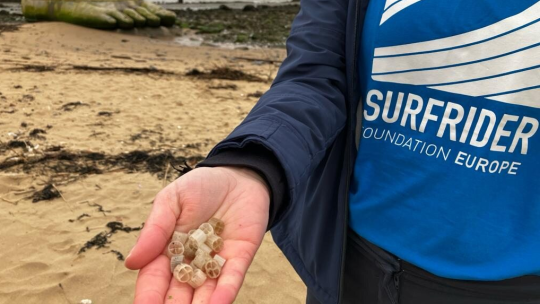Surfrider Foundation, an NGO working for the protection of the ocean, is unveiling its report on biomedia pollution, to enable all stakeholders to take stock of the problem and its impact on the environment. The NGO has supplemented the report with a guide containing recommendations for all concerned.
What are biomedia?
Biomedia are plastic supports used in wastewater treatment plants (WWTPs) during the biological water treatment phase. During this phase, bacteria break down organic matter, nitrogen and phosphorus.
A number of wastewater treatment plants using this process are experiencing malfunctions and are therefore at risk of releasing plastic biomedias into the environment.
Biomedias are an additional source of plastic pollution with disastrous consequences for the marine environment, as a treatment tank can contain several hundred million biomedias.
The pollution can continue for years, spreading over very long distances and impacting protected areas. They can be ingested by marine animals and have harmful effects on marine biodiversity, and their toxicity is a cause for concern.
Increasing pollution
Since the end of the 2010s, massive discharges of biomedias into aquatic environments (from several thousand to several million units) have been observed in Europe. Here are a few examples:
- Biomedias that escaped from a WWTP in the Spanish Basque Country in 2010 are still washing up on the beaches of the Atlantic coast in large numbers, 13 years after the accident.
- In Italy in 2018, between 126 and 130 million biomedias from the municipal WWTP in the town of Capaccio Paestum were discharged into the river Sele, which flows into the Tyrrhenian Sea. The pollution spread throughout the western Mediterranean, affecting the coastlines of France, Spain, Tunisia and Malta and impacting numerous protected marine areas.
- In March 2021, around half a million biomedias were also discharged into the Ringkøbing fjord (Denmark) and reached the North Sea, following an accident at a salmon farm.
A report to alert decision-makers
In order to alert decision-makers to this little-known waste, Surfrider has just put a report online to share with as many people as possible the information gathered by the Surfrider Foundation over the 15 years it has been investigating the issue of biomedia. It follows on from an initial report in 2018 and provides an update on Surfrider’s data and expertise over the last 5 years.
Several reports and numerous scientific articles (FNDAE…) present the use of biomedias, the different processes for their use, the comparison of different bacterial supports and many other parameters, but none of them takes into account the impact of their dispersion in the natural environment following malfunctions.
“Our approach is part of a preventive objective, and through our work we want to contribute to a better understanding and consideration of the issues leading to the loss of biomedias into the environment,” explains Philippe Bencivengo, Surfrider’s biomedias project manager.
Best practice guide for operators
Biomedia leakages fall into two main categories: massive one-off (acute) leaks and chronic diffuse leaks, which are more difficult to detect. Municipal and industrial wastewater treatment plants of all sizes and in all locations can be affected.
That’s why Surfrider, with the support of the Swedish Environmental Protection Agency, has produced a guide for users and operators.
Its aim is to draw up recommendations for the safe management of biomedias based on technical solutions and existing management measures that have been proven to be effective, with the main aim of preventing the discharge of biomedias into aquatic environments.
This guide offers practical solutions on a number of aspects: production, transport, storage, failure risk analysis, design and construction of WWTPs, installation monitoring, etc.
“Some of these recommendations are common sense and very inexpensive to implement. Their effects can be quick,” explains Philippe Bencivengo. He adds: “At every stage in the life cycle of biomedias, the training of stakeholders (designers, operators, inspectors and monitoring services) is essential if the risks associated with biomedia losses are to be properly taken into account. Involving stakeholders from the outset should ensure that operations run smoothly. It is therefore up to the stakeholders to implement the most obvious measures that can be achieved quickly and at low cost,” he concludes.



